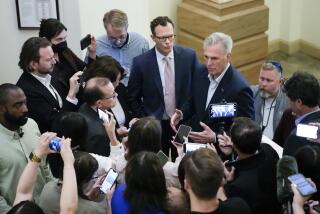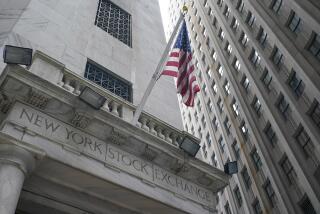U.S. proposes sweeping bailout
- Share via
WASHINGTON — In what could be the biggest bailout since the Great Depression, top government officials and congressional leaders agreed late Thursday to quickly develop a comprehensive plan aimed at defusing the nation’s roiling financial crisis.
The plan would relieve financial institutions of the mortgage-backed securities and other bad assets that are threatening the nation’s economic health.
Under the proposal, details of which were not announced, Washington would buy the distressed assets, allowing banks to resume their usual borrowing and lending, according to people familiar with the plan. The approach could be similar to the formation of the Resolution Trust Corp. during the 1980s to resolve the savings and loan crisis.
In a meeting between lawmakers and Treasury Secretary Henry M. Paulson Jr. and Federal Reserve Chairman Ben S. Bernanke, the top officials suggested that once the financial system was rebooted in this fashion, the government would be able to sell off the assets to recover taxpayers’ money and perhaps even turn a profit, according to the people privy to the plan, who spoke on condition of anonymity because they were not authorized to speak publicly.
The plan could be unveiled as early as today and voted on by Congress by next week.
News of the rescue plan sent Asian markets soaring this morning.
Lawmakers emerging from a 90-minute session in the offices of House Speaker Nancy Pelosi (D-San Francisco) said they expected a detailed proposal from Bernanke and Paulson overnight and to work through the weekend in an effort to pass it quickly into law.
The tone at the meeting was deadly serious, as Paulson and Bernanke stressed to lawmakers that the crisis could get far worse.
“I think we had some sobering news tonight,” Sen. Richard Shelby (R-Ala.), top Republican on the Senate Banking committee, said as he left the meeting.
Members of both parties pledged in a brief news conference to work cooperatively.
“It’s clear that even though we’re just six weeks away from an election, our job is to put our partisan differences aside and to work to help solve this crisis,” said House Minority Leader John A. Boehner (R-Ohio).
The meeting capped a day of high drama as government officials, lawmakers and traders sought to keep the financial contagion that staggered markets on Wednesday from resuming its destructive course. To ease the credit crisis, the Fed announced early Thursday that it would boost to nearly $250 billion the funds available for major foreign central banks. Meanwhile, the Securities and Exchange Commission signaled its intention to follow its British counterpart in issuing a temporary ban on short selling.
Short selling is a means of betting that a stock’s price will fall by selling borrowed shares in hopes they can be repurchased at a lower price. The practice has been increasingly blamed for causing sudden drops in companies’ stock values, frightening away lenders and leaving the firms financially beached.
SEC Chairman Christopher Cox was meeting with commissioners late Thursday. “We are likely to take additional steps in the days ahead that are more particularly addressed to this urgent situation,” Cox said.
Early reports that a comprehensive rescue was in the works caused U.S. stock prices to reverse course from Wednesday.
Traders on the New York Stock Exchange broke into cheers Thursday as the bellwether Dow Jones industrial average switched from a 200-point loss to a rise of 410.03 points, or 3.9%, at 11,019.69. The Nasdaq composite index gained 100.25 points, or 4.8%, ending at 2,199.10, and the Standard & Poor’s 500 Index climbed 50.12 points, or 4.3%, to close at 1,206.33, its largest one-day percentage gain in nearly six years.
Paulson and Bernanke acted on their new plan after two tumultuous weeks in which policymakers took ad hoc steps that failed to reassure panicky investors. They seized mortgage giants Fannie Mae and Freddie Mac as well as insurance behemoth American International Group Inc., and effectively pulled the plug on investment banks Lehman Bros. Holdings Co. and Merrill Lynch & Co. They also coaxed a group of 10 big financial institutions to kick into a $70-billion self-insurance pool and pumped out billions of dollars more to try to reverse a new and dangerous credit market freeze-up.
The full dimensions of Washington’s intervention came into focus late Thursday when the Fed issued figures showing it had made nearly $100 billion in special loans to financial firms around the world in the last week alone.
Separately, Treasury announced that it would double to $200 billion the amount of government securities it would sell at special auctions to raise money to bolster the Fed’s finances. The department had announced Wednesday the first $100 billion in auctions.
According to those familiar with Bernanke’s and Paulson’s thinking, both of these efforts would be dwarfed by the new plan -- the price of which could run into the hundreds of billions of dollars or more.
Much about the plan remained uncertain, and working out the details promises to be difficult for lawmakers, who are on edge because of the upcoming election.
A protracted legislative battle over the plan could have a calamitous effect on the battered financial system -- a possibility that congressional leaders seemed to recognize in their pledges for quick, bipartisan action.
For example, would the government take the bad assets on its own books or create a separate entity?
Would the government allow only certain types of institutions like banks to sell their troubled investments to Washington, or would auctions be open to all comers?
Would only certain kinds of assets, such as mortgage-backed securities or so-called collateralized debt obligations, be eligible for sale, or could institutions unload any kind of bad investments?
And behind all these questions lurks an even more difficult one: Is there any way to determine what the bad assets being sold are worth to ensure the government doesn’t get cheated in the deal?
In fact, it is the assets that are the hardest to sell and therefore the hardest to value that are at the heart of the current crisis. They are also the ones financial institutions will be most eager to hand over to the government.
Paulson and Bernanke apparently hope to solve this problem by using an auction where the government would buy the troubled assets of those asking the lowest prices.
But the simple fact of such a giant government intervention in private markets and the lack of any effective guide to tell whether Washington is paying a reasonable amount could prove a political obstacle.
“I’m deeply troubled by this plan,” Sen. Jim DeMint (R-S.C.) said. “What is missing from it and from the recent string of bailouts is a commitment to return to a free enterprise economy. . . . What we need now is not what could be nearly a trillion dollars in new taxpayer bailouts but pro-growth policies that allow our markets to correct and start growing again.”
After keeping a low profile on the economic crisis all week, President Bush stepped before the cameras Thursday. He canceled plans to travel to Florida and Alabama for political fundraisers and instead received a briefing on the financial situation from Paulson and other advisors, then delivered a short statement.
“As our recent actions demonstrate, my administration is focused on meeting these challenges,” Bush said. “The American people can be sure we will continue to act to strengthen and stabilize our financial markets and improve investor confidence.”
Bush’s comments appeared to make little impression on the markets, which continued to fall until the final hour of trading, when rumors of a comprehensive rescue plan set off a rally.
“I’ve been running funds in this space for 12 1/2 years, and this is the craziest day I’ve seen,” said Anton Schutz, manager of Burnham Financial Funds in New York. “One minute you’re terrified and stock prices are melting and the next minute they’re bouncing back.”
--
maura.reynolds@latimes.com
richard.simon@latimes.com
--
(BEGIN TEXT OF INFOBOX)
Daily developments
The government works on a plan to buy distressed assets from banks and other institutions to be resold in an orderly fashion.
The Dow Jones industrial average jumps 3.9%, the largest one-day percentage gain in nearly six years.
U.S. regulators look to curb short selling -- bets that stocks will go down -- after Britain bans short selling in the country’s major financial stocks for the rest of the year.
More to Read
Inside the business of entertainment
The Wide Shot brings you news, analysis and insights on everything from streaming wars to production — and what it all means for the future.
You may occasionally receive promotional content from the Los Angeles Times.









